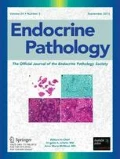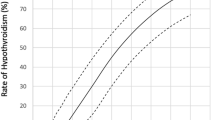Abstract
An increased incidence of thyroid cancer in the exposed children remains the most well-documented long-term effect of radioactive contamination after the Chernobyl nuclear accident in April, 1986. Multiple studies on approx 4000 children and adolescents with thyroid cancer have provided important new information about the epidemiological, clinical, pathological, and molecular aspects of radiation-induced carcinogenesis in the thyroid gland. They revealed that environmental exposure to 131l during childhood carries an increased risk of thyroid cancer and the risk is radiation dose dependent. The youngest children are most sensitive to radiation-induced carcinogenesis, and the minimal latent period for thyroid cancer development after exposure is as short as 4 yr. The vast majority of these cancers are papillary carcinomas, many of which have characteristic solid or solid-follicular microscopic appearance. On the molecular level, post-Chernobyl tumors are characterized by frequent occurrence of chromosomal rearrangements, such as RET/PTC, whereas point mutations of BRAF and other genes are much less common in this population.
Similar content being viewed by others
References
Exposures and effects of the Chernobyl accident. UNSCEAR 2000 Report Vol 2 Annex J. In. New York and Geneva: United Nations; 2000.
Chernobyl’s Legacy: Health, Environmental and Socio-Economic Impacts. In: The Chernobyl Forum 2003–2005; 2005.
Cardis E, Howe G, Ron E, et al. Cancer consequences of the Chernobyl accident: 20 years on. J Radiol Prot 26:127–140, 2006.
Kazakov VS, Demidchik EP, Astakhova LN. Thyroid cancer after Chernobyl. Nature 359:21, 1992.
Stsjazhko VA, Tsyb AF, Tronko ND, et al. Childhood thyroid cancer since accident at Chernobyl. BMJ 310:801, 1995.
Baverstock K, Egloff B, Pinchera A, et al. Thyroid cancer after Chernobyl. Nature 359:21–22, 1992.
Cardis E, Kesminiene A, Ivanov V, et al. Risk of thyroid cancer after exposure to 1311 in childhood. J Natl Cancer Inst 97:724–732, 2005.
Astakhova LN, Anspaugh LR, Beebe GW, et al. Chernobyl-related thyroid cancer in children of Belarus: a case-control study. Radiat Res 150:349–356, 1998.
Davis S, Stepanenko V, Rivkind N, et al. Risk of thyroid cancer in the Bryansk Oblast of the Russian Federation after the Chernobyl Power Station accident. Radiat Res 162:241–248, 2004.
Tronko MD, Howe GR, Bogdanova TI, et al. A cohort study of thyroid cancer and other thyroid diseases after the chornobyl accident: thyroid cancer in Ukraine detected during first screening. J Natl Cancer Inst 98:897–903, 2006.
Ron E, Lubin JH, Shore RE, et al. Thyroid cancer after exposure to external radiation: a pooled analysis of seven studies. Radiat Res 141:259–277, 1995.
Jacob P, Bogdanova TI, Buglova E, et al. Thyroid cancer among Ukrainians and Belarusians who were children or adolescents at the time of the Chernobyl accident. J Radiol Prot 26:51–67, 2006.
Shakhtarin V, Tsyb A, Stepanenko V, et al. Iodine deficiency, radiation dose, and the risk of thyroid cancer among children and adolescents in the Bryansk region of Russia following the Chernobyl power station accident. Int J Epidemiol 32:584–591, 2003.
Ivanov VK, Gorski AI, Maksioutov MA, et al. Thyroid cancer incidence among adolescents and adults in the Bryansk region of Russia following the Chernobyl accident. Health Phys 84:46–60, 2003.
Nikiforov Y, Gnepp DR. Pediatric thyroid cancer after the Chernobyl disaster. Pathomorphologic study of 84 cases (1991–1992) from the Republic of Belarus. Cancer 74:748–766, 1994.
Pacini F, Vorontsova T, Demidchik EP, et al. Post-chernobyl thyroid carcinoma in Belarus children and adolescents: comparison with naturally occurring thyroid carcinoma in Italy and France. J Clin Endocrinol Metab 82: 3563–3569, 1997.
Tronko MD, Bogdanova TI, Komissarenko IV, et al. Thyroid carcinoma in children and adolescents in Ukraine after the Chernobyl nuclear accident: statistical data and clinicomorphologic characteristics. Cancer 86:149–156, 1999.
Williams D. Cancer after nuclear fallout: lessons from the Chernobyl accident. Nat Rev Cancer 2:543–549, 2002.
Cardis E, Amoros E, Kesminiene A, et al. Observed and predicted thyroid cancer incidence following the Chernobyl accident: evidence for factors influencing susceptibility to radiation induced thyroid cancer. In: Thomas G, Karaoglou A, Williams DE, eds. Radiation and thyroid cancer. Singapore: World Scientific, 1999:395–405.
Jacob P, Bogdanova TI, Buglova E, et al. Thyroid cancer risk in areas of Ukraine and Belarus affected by the Chernobyl accident. Radiat Res 165:1–8, 2006.
Saad A, Falciglia M, Steward DL, et al. Amiodarone-induced thyrotoxicosis and thyroid cancer: clinical, immunohistochemical, and molecular genetic studies of a case and review of the literature. Arch Pathol Lab Med 128:807–810, 2004.
Faggiano A, Coulot J, Bellon N, et al. Age-dependent variation of follicular size and expression of iodine transporters in human thyroid tissue. J Nucl Med 45:232–237, 2004.
Furmanchuk AW, Averkin JI, Egloff B, et al. Pathomorphological findings in thyroid cancers of children from the Republic of Belarus: a study of 86 cases occurring between 1986 (“post-Chernobyl”) and 1991. Histopathology 21:401–408, 1992.
Nikiforov YE, Erickson LA, Nikiforova MN, et al. Solid variant of papillary thyroid carcinoma: incidence, clinical-pathologic characteristics, molecular analysis, and biologic behavior. Am J Surg Pathol 25:1478–1484, 2001.
Rabes HM, Demidchik EP, Sidorow JD, et al. Pattern of radiation-induced RET and NTRK1 rearrangements in 191 post-chernobyl papillary thyroid carcinomas: biological, phenotypic, and clinical implications. Clin Cancer Res 6:1093–1103, 2000.
Thomas GA, Bunnell H, Cook HA, et al. High prevalence of RET/PTC rearrangements in Ukrainian and Belarussian post-Chernobyl thyroid papillary carcinomas: a strong correlation between RET/PTC3 and the solid-follicular variant. J Clin Endocrinol Metab 84:4232–4238, 1999.
Williams ED, Abrosimov A, Bogdanova T, et al. Thyroid carcinoma after Chernobyl latent period, morphology and aggressiveness. Br J Cancer 90:2219–2224, 2004.
Ceccarelli C, Pacini F, Lippi F, et al. Thyroid cancer in children and adolescents. Surgery 104:1143–1148, 1988.
La Quaglia MP, Black T, Holcomb GW, 3rd, et al. Differentiated thyroid cancer: clinical characteristics, treatment, and outcome in patients under 21 years of age who present with distant metastases. A report from the Surgical Discipline Committee of the Children's Cancer Group. J Pediatric Surg 35:955–959; discussion 960, 2000.
Schlumberger M, De Vathaire F, Travagli JP, et al. Differentiated thyroid carcinoma in childhood: long term follow-up of 72 patients. J Clin Endocrinol Metabol 65:1088–1094, 1987.
Fugazzola L, Pilotti S, Pinchera A, et al. Oncogenic rearrangements of the RET proto-oncogene in papillary thyroid carcinomas from children exposed to the Chernobyl nuclear accident. Cancer Res 55:5617–5620, 1995.
Ito T, Seyama T, Iwamoto KS, et al. Activated RET oncogene in thyroid cancers of children from areas contaminated by Chernobyl accident. Lancet 344:259, 1994.
Klugbauer S, Lengfelder E, Demidchik EP, et al. High prevalence of RET rearrangement in thyroid tumors of children from Belarus after the Chernobyl reactor accident. Oncogene 11:2459–2467, 1995.
Nikiforov YE, Rowland JM, Bove KE, et al. Distinct pattern of ret oncogene rearrangements in morphological variants of radiation-induced and sporadic thyroid papillary carcinomas in children. Cancer Res 57:1690–1694, 1997.
Grieco M, Santoro M, Berlingieri MT, et al. PTC is a novel rearranged form of the ret proto-oncogene and is frequently detected in vivo in human thyroid papillary carcinomas. Cell 60:557–563, 1990.
Bongarzone I, Butti MG, Coronelli S, et al. Frequent activation of ret protooncogene by fusion with a new activating gene in papillary thyroid carcinomas. Cancer Res 54:2979–2985, 1994.
Santoro M, Dathan NA, Berlingieri MT, et al. Molecular characterization of RET/PTC3; a novel rearranged version of the RET proto-oncogene in a human thyroid papillary carcinoma. Oncogene 9:509–516, 1994.
Jhiang SM, Sagartz JE, Tong Q, et al. Targeted expression of the ret/PTC1 oncogene induces papillary thryoid carcinomas. Endocrinology 137:375–378, 1996.
Santoro M, Chiappetta G, Cerrato A, et al. Development of thyroid papillary carcinomas secondary to tissue-specific expression of the RET/PTC1 oncogene in transgenic mice. Oncogene 12:1821–1826, 1996.
Powell DJ, Jr, Russell J, Nibu K, et al. The RET/PTC3 oncogene: metastatic solid-type papillary carcinomas in murine thyroids. Cancer Res 58:5523–5528, 1998.
Nikiforov YE. RET/PTC rearrangement in thyroid tumors. Endocr Pathol 13:3–16, 2002.
Smida J, Salassidis K, Hieber L, et al. Distinct fequency of ret reaarangements in papillary thyroid carcinomas of children and adults from Belarus. Int J Cancer 80:32–38, 1999.
Klugbauer S, Demidchik EP, Lengfelder E, et al. Molecular analysis of new subtypes of ELE/RET rearrangements, their reciprocal transcripts and breakpoints in papillary thyroid carcinomas of children after Chernobyl. Oncogene 16:671–675, 1998.
Klugbauer S, Rabes HM. The transcription coactivator HTIF1 and a related protein are fused to the RET receptor tyrosine kinase in childhood papillary thyroid carcinomas. Oncogene 18:4388–4393, 1999.
Klugbauer S, Jauch A, Lengfelder E, et al. A novel type of RET rearrangement (PTC8) in childhood papillary thyroid carciomas and characterization of the involved gene (RFG8). Cancer Res 60:7028–7032, 2000.
Salassidis K, Bruch J, Zitzelsberger H, et al. Translocation t(10;14)(q11.2:q22.1) fusing the kinetin to the RET gene creates a novel rearranged form (PTC8) of the RET protooncogene in radiation-induced childhood papillary thyroid carcinoma. Cancer Res 60:2786–2789, 2000.
Rabes HM. Gene rearrangements in radiationinduced thyroid carcinogenesis. Med Pediatr Oncol 36:574–582, 2001.
Ito T, Seyama T, Iwamoto KS, et al. In vitro irradiation is able to cause RET oncogene rearrangement. Cancer Res 53:2940–2943, 1993.
Caudill CM, Zhu Z, Ciampi R, et al. Dosedependent generation of RET/PTC in human thyroid cells after in vitro exposure to gammaradiation: a model of carcinogenic chromosomal rearrangement induced by ionizing radiation. J Clin Endocrinol Metab 90:2364–2369, 2005.
Mizuno T, Kyoizumi S, Suzuki T, et al. Continued expression of a tissue specific activated oncogene in the early steps of radiation-induced human thyroid carcinogenesis. Oncogene 15:1455–1460, 1997.
Mizuno T, Iwamoto KS, Kyoizumi S, et al. Preferential induction of RET/PTC1 rearrangement by X-ray irradiation. Oncogene 19:438–443, 2000.
Nikiforova MN, Stringer JR, Blough R, et al. Proximity of chromosomal loci that participate in radiation-induced rearrangements in human cells. Science 290:138–141, 2000.
Gandhi M, Medvedovic M, Stringer JR, et al. Interphase chromosome folding determines spatial proximity of genes participating in carcinogenic RET/PTC rearrangements. Oncogene 25:2360–2366, 2006.
Ciampi R, Knauf JA, Kerler R, et al. Oncogenic AKAP9-BRAF fusion is a novel mechanism of MAPK pathway activation in thyroid cancer. J Clin Invest 115:94–101, 2005.
Beimfohr C, Klugbauer S, Demidchik EP, et al. NTRK1 re-arrangement inpapillary thyroid carcinomas of children after the Chernobyl reactor accident. Int J Cancer 80:842–847, 1999.
Nikiforova MN, Ciampi R, Salvatore G, et al. Low prevalence of BRAF mutations in radiation-induced thyroid tumors in contrast to sporadic papillary carcinomas. Cancer Lett 209:1–6, 2004.
Kumagai A, Namba H, Saenko VA, et al. Low frequency of BRAFT1796A mutations in childhood thyroid carcinomas. J Clin Endocrinol Metab 89:4280–4284, 2004.
Lima J, Trovisco V, Soares P, et al. BRAF mutations are not a major event in pos-Chernobyl childhood thyroid carcinomas. J Clin Endocrinol Metab 89:4267–4271. 2004.
Powell N, Jeremiah S, Morishita M, et al. Frequency of BRAFT1796A mutation in papillary thyroid carcinoma relates to age of patient at diagnosis and not to radiation exposure. J Pathol 205:558–564, 2005.
Kimura ET, Nikiforova MN, Zhu Z, et al. High prevalence of BRAF mutations in thyroid cancer: genetic evidence for constitutive activation of the RET/PTC-RAS-BRAF signaling pathway in papillary thyroid cancer: genetic evidence for constitutive activation of the RET/PTC-RAS-BRAF signaling pathway in papillary thyroid carcinoma. Cancer Res 63:1454–1457, 2003.
Cohen Y, Xing M, Mambo E, et al. BRAF mutation in papillary thyroid carcinoma. J Natl Cancer Inst 95:625–627, 2003.
Nikiforov YE, Nikiforova MN, Gnepp DR, et al., Prevalence of mutations of ras and p53 in benign and malignant thyroid tumors from children exposed to radiation after the Chernobyl nuclear accident. Oncogene 13:687–693, 1996.
Santoro M, Thomas GA, Vecchio G, et al. Gene rearrangement and Chernobyl related thyroid cancers. Br J Cancer 82:315–322, 2000.
Suchy B, Waldmann V, Klugbauer S, et al. Absence of RAS and p53 mutations in thyroid carcinomas of children after Chernobyl in contrast to adult thyroid tumours. Br J Cancer 77:952–955, 1998.
Author information
Authors and Affiliations
Corresponding author
Rights and permissions
About this article
Cite this article
Nikiforov, Y.E. Radiation-induced thyroid cancer: What we have learned from Chernobyl. Endocr Pathol 17, 307–318 (2006). https://doi.org/10.1007/s12022-006-0001-5
Issue Date:
DOI: https://doi.org/10.1007/s12022-006-0001-5




